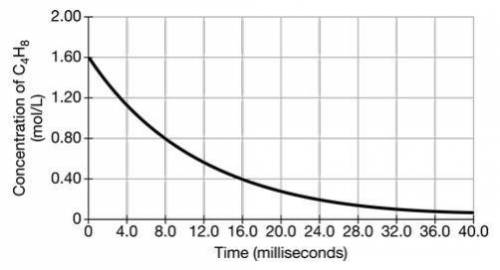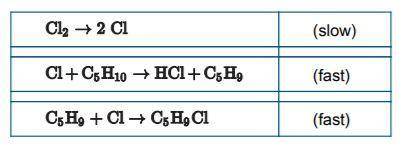
Chemistry, 06.05.2020 02:31 cefindley14
(i) Based on the graph, determine the order of the decomposition reaction of cyclobutane at 1270 K. Justify your answer.
(ii) Calculate the time, in milliseconds, that it would take for 99 percent of the original cyclobutane at 1270 K to decompose.
Another alkane with a ring structure is cyclopentane, C5H10(g). Cyclopentane reacts with
chlorine, Cl2(g) , to produce C2H9Cl(g) and HCl(g) . Following is a representation of a proposed mechanism for the reaction.
*kinetics table attached
(d) Write a rate law for the reaction that is consistent with the mechanism. Justify your answer.
(e) A student claims that, Cl2(g), is a catalyst in the reaction. Explain why the student’s claim is
false.



Answers: 1
Another question on Chemistry

Chemistry, 21.06.2019 22:00
If 1.63 times 10 negative 4 of helium dissolves in 100.0g of water, what is the concentration in parts per million
Answers: 3

Chemistry, 22.06.2019 04:30
Both josef loschmidt and amedeo avogadro contributed to our understanding of basic molecular numbers, sizes, and reaction ratios. neither scientist discovered “avogadro’s number” in the form we use it today (6.02 x 10 23). still, there’s a controversy over the name. research the contributions from these two scientists and read about how avogadro’s number got its name. briefly state what you think this number should be called, providing key details of each scientist’s contributions to this concept and a solid rationale for your case in naming the number.
Answers: 2

Chemistry, 22.06.2019 07:00
The variability in marine salinity between habitats does not impact the fish living there. select the best answer from the choices provided t f
Answers: 1

Chemistry, 22.06.2019 11:40
Effect of rotenone and antimycin a on electron transfer rotenone, a toxic natural product from plants, strongly inhibits nadh dehydrogenase of insect and fish mitochondria. antimycin a, a toxic antibiotic, strongly inhibits the oxidation of ubiquinol. (a) explain why rotenone ingestion is lethal to some insect and fish species. (b) explain why antimycin a is a poison. (c) given that rotenone and antimycin a are equally effective in blocking their respective sites in the electron-transfer chain, which would be a more potent poison? explain.
Answers: 3
You know the right answer?
(i) Based on the graph, determine the order of the decomposition reaction of cyclobutane at 1270 K....
Questions

Mathematics, 12.04.2021 17:40

Physics, 12.04.2021 17:40






Mathematics, 12.04.2021 17:40


History, 12.04.2021 17:40


Mathematics, 12.04.2021 17:40


Mathematics, 12.04.2021 17:40





Social Studies, 12.04.2021 17:40

Biology, 12.04.2021 17:40



